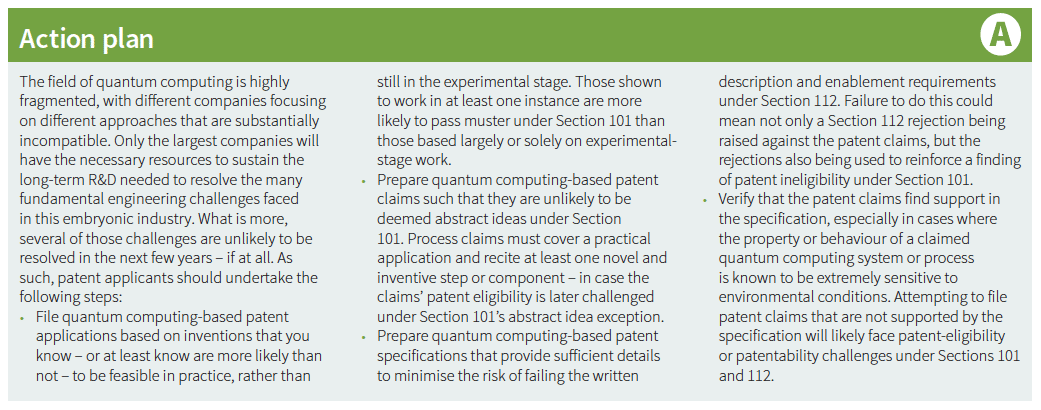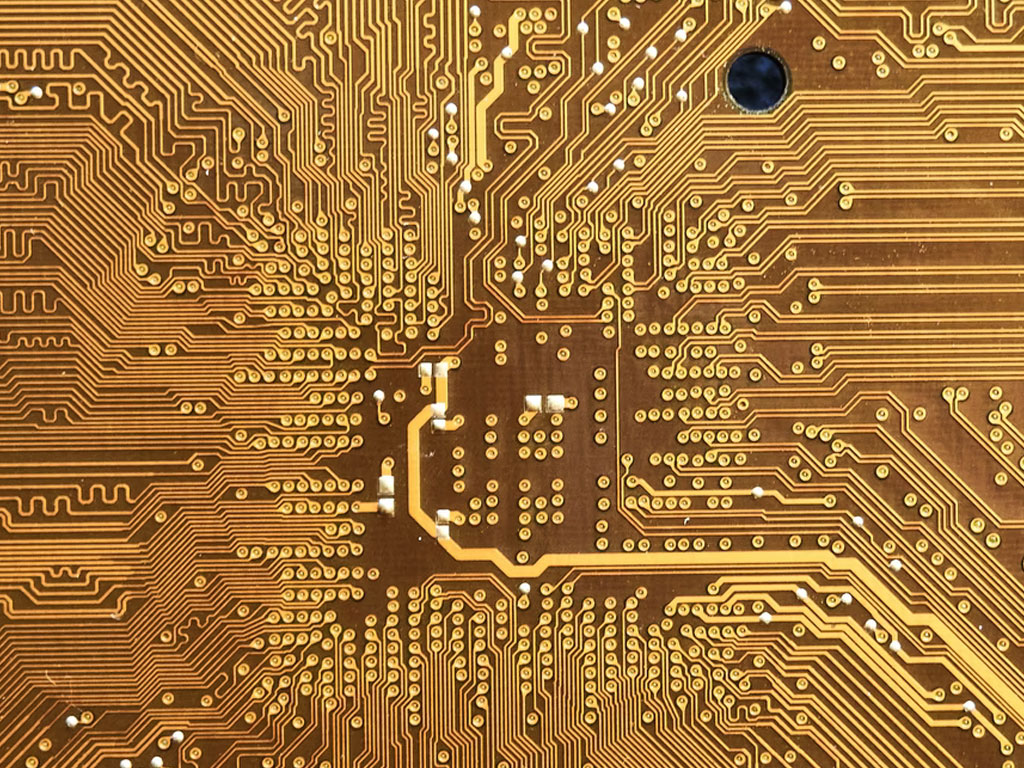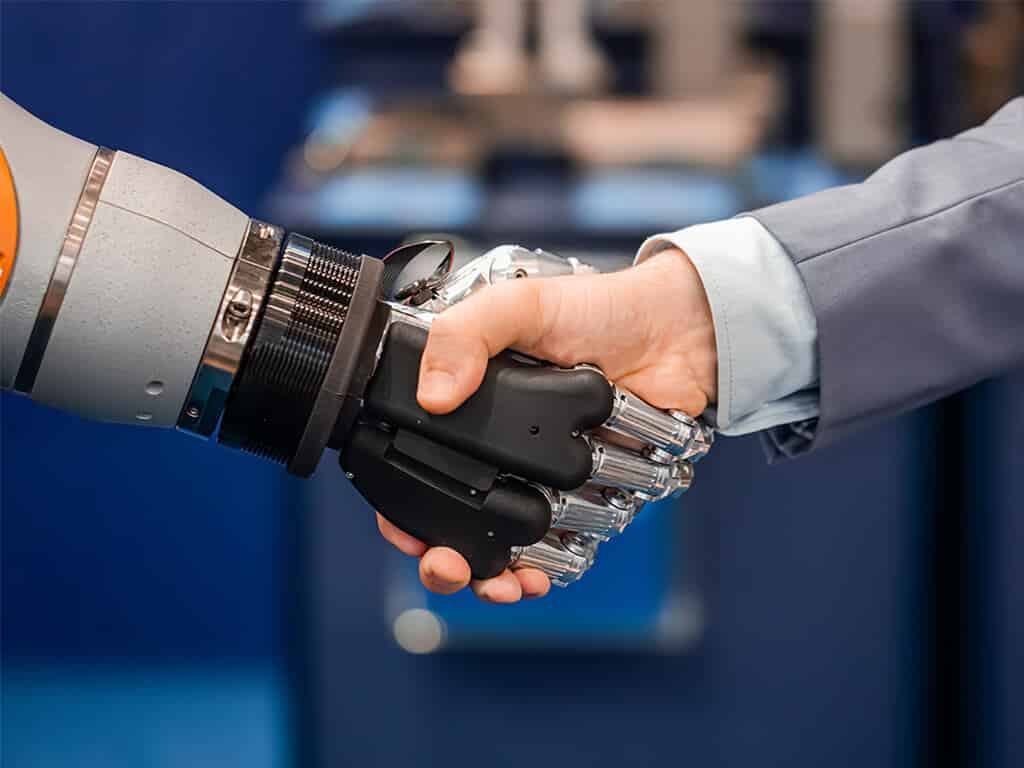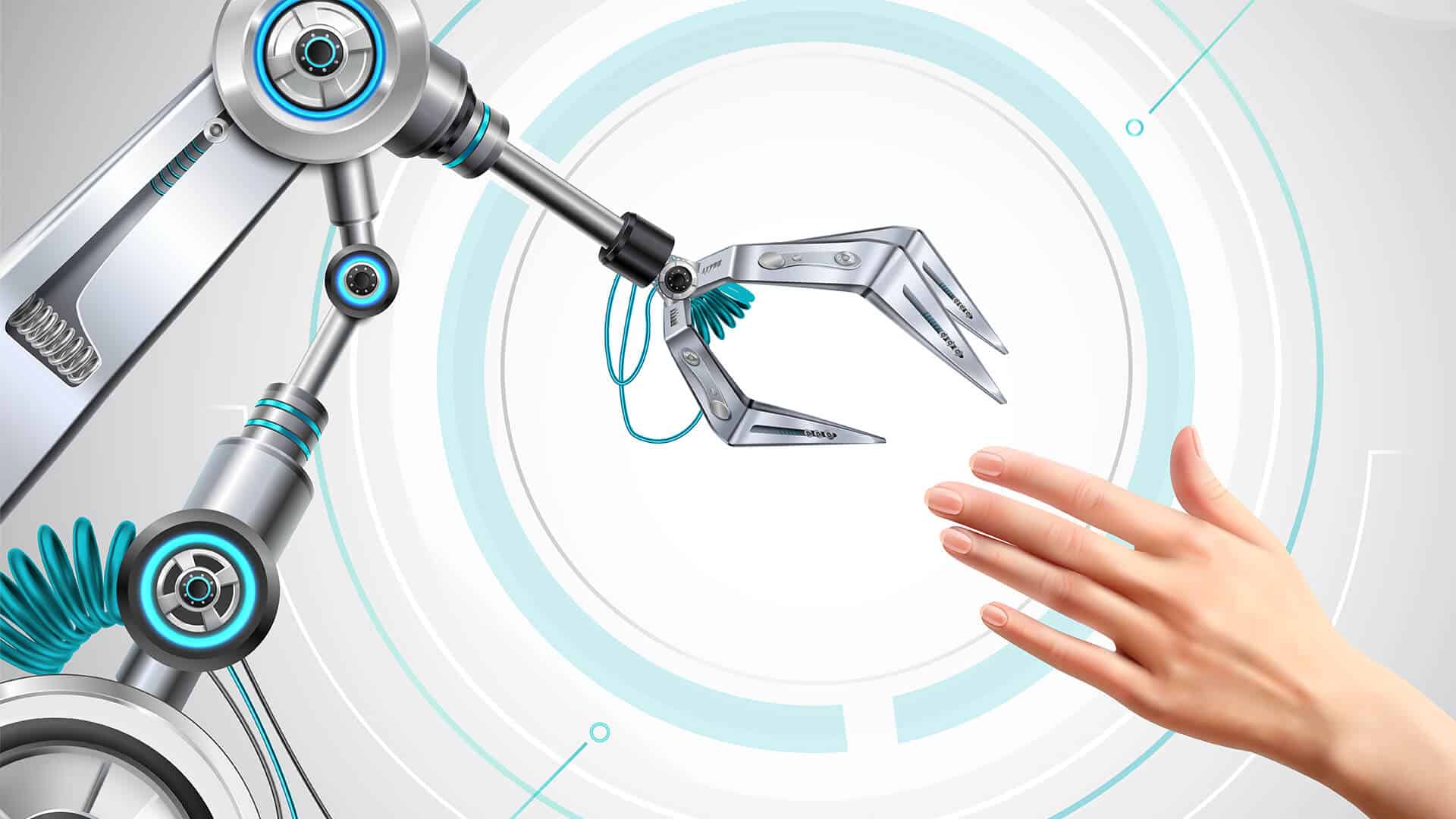“This article first appeared in IAM Spring Issue 99, published by Law Business Research – IP Division. To view the issue in full, please go to www.IAM-media.com”
Patent data shows that some of the world’s largest tech companies are jockeying for leadership in a new era of innovation, but those in the United States still face several challenges when it comes to prosecuting the strongest IP rights possible
Quantum computing will change the world as we know it – or at least that is what some proponents of the field claim. Hyperbole aside, quantum computing is generally considered to be a paradigm-shifting technology with the potential to become a practical and enormously useful computing platform that complements existing computers.
But the field is still very much in its infancy. As such, it will need these lofty aspirations to overcome the engineering hurdles that it faces, which must happen before at least some of this hype can be converted into practical tools.
In fact, some cringe at the sector’s adoption of the term ‘quantum supremacy’; when Google announced that it had just reached this milestone, IBM wasted no time in publicly disputing the claim. But less technically inclined individuals would be forgiven for mistaking quantum supremacy for some kind of final breakthrough, an announcement that quantum computing – despite the scepticism – has finally arrived, heralding a new era of technological prowess, which will – with the help of next-level AI – completely reconfigure our world and create a supremely advanced civilisation.
The fact is that ‘quantum supremacy’ merely refers to one of the earliest milestones that must be met before the growing but still embryonic field of quantum computing can become a practical reality. The choice of the term is unfortunate because it belies the enormous difficulties that the field faces and the long time horizon that it will likely require to accomplish its goals.
At this point, no one knows for sure whether practical quantum computing is achievable within the next decade or whether it will be superseded by an inferior – albeit far more feasible and practical – nascent technology before it gains sufficient traction. The latter is likely if public support for, and investor interest in, the field were to fizzle out because it became stuck in some intractable technical morass.
Quantum computing patents: avoiding the rabbit hole
The fact that quantum computing is still in its rudimentary stages in the patent arena means that companies looking to file early quantum computing-based patent applications must carefully draft their claims so as to minimise potential patent-eligibility issues relating to Section 101 of the US patent statute. To further reduce the likelihood of these applications being dealt a fatal blow by Alice’s two-prong test if found to fall under Section 101’s abstract idea exception, the patent specifications must provide sufficient details to ensure that they comply with Section 112’s written description and enablement requirements. Otherwise, a rejection based on Section 112 could be used to bolster a finding of patent ineligibility under Section 101.
The fact that quantum computing is a highly experimental field – although one based on an abstract theoretical framework for describing microscopic phenomena – could mean that entities that invest significant resources to develop quantum computing-based technologies may not need to worry that potential quantum computing-based patents similar to the patent at issue in Alice will be asserted against them. However, no one can prevent enterprising individuals whose knowledge of quantum computing is derived mostly from reading related news articles and press releases from filing patent applications with skimpy specifications and claims that reflect the field’s status as the next big thing. Such vague claims may include ones that recite, for example, “enhancing the security of bitcoin-based transactions by encrypting the transactions using quantum computing, quantum cryptography and at least one type of substantially error-free quantum bit that includes supercooled and ion-trapped ions”.
Why do we need quantum computing?
Quantum computing systems differ from conventional computers primarily because they use quantum bits (qubits), rather than the bits that are used in traditional computers and with which most of us are familiar. By definition, ordinary bits (short for binary digits) can assume one of only two possible values: 1 or 0. Unlike ordinary bits, a qubit can assume not only a value of 1 or 0, but also any combination of 1 and 0. This allows quantum computing to perform exponentially more complex computational tasks – at least in principle.
But quantum computing is not considered to be a next-generation successor to our bit-based computers. Instead, it is intended to complement them. ‘Classical’ (ie, conventional) computers are almost certain to remain useful in the foreseeable future for countless daily tasks, as they are relatively affordable, require little maintenance and are easy to use. The primary goal of quantum computing is to use quantum computing-based systems for computational tasks that would be highly impractical using conventional computers.
The technology is projected to be useful for many diverse applications, including cryptography, drug and material design, sensing and measurement, and imaging. For example, a major driving force for developing practical quantum computing is to develop network security systems capable of withstanding new and emerging threats to current encryption schemes. Although, in theory, conventional computers can decrypt passwords that rely on the most effective existing encryption technologies, it would take thousands of years for them to unlock the entire password.
Attaining practical quantum computing
According to the National Academies of Sciences, Engineering and Medicine’s 2018 report “Quantum Computing: Progress and Prospects”, the following challenges must be addressed before practical quantum computers can become a reality:
- Qubits are extremely error prone and practical computation requires low error rates.
- It is highly challenging to reduce qubit errors.
- It is not currently possible to input large amounts of data into a quantum computer efficiently.
- A computer needs software to operate but designing quantum computing algorithms is extremely difficult.
To get a sense of how the entire field is progressing, researchers benchmark the performance of quantum computing systems by measuring how well they can perform a specific task compared to conventional computers. A critical milestone is whether a quantum computing system meets or exceeds a computational performance threshold, which researchers refer to as ‘quantum supremacy’ or ‘quantum advantage’. ‘Quantum supremacy’ generally refers to a point at which quantum computing can perform a specific computing task that would be impossible for classical computers to complete within a reasonable timeframe. ‘Quantum advantage’ refers to a point where a computing task that classical computers can complete within a reasonable timeframe can be performed more quickly by a quantum computer.
Required components
Quantum computing systems require various components, including hardware, software for running algorithms and applications, control systems for performing gate operations and means for performing error corrections, as well as techniques for integrating classical and quantum computation. Other components and functionalities are also needed to configure real-world problems into a format that is amenable to quantum computing. These include hardware such as:
- physical qubits;
- processors;
- control circuits;
- interfaces;
- detectors, chips for trapping ions, vacuum, laser, microwave or optical system (ion-trapped);
- wirings;
- refrigeration;
- housing (so-called ‘package’); and
- signal shielding.
They also include software to address issues such as:
- error correction;
- control processing languages;
- • specification;
- • simulation;
- • debugging;
- • programming languages;
- • compilers;
- • schedulers;
- • optimisation (eg, resource estimators);
- • verification or validation; and
- • function libraries.
Among the various components, hardware and control systems are considered to be the most challenging.

Because developing quantum computing components requires significant resources, only a handful of companies (eg, IBM, Microsoft, Google, Microsoft, Rigetti and D-Wave) do R&D in multiple or all related areas. The rest focus on one or two relevant components only.
Patenting issues relating to quantum computing-based inventions
Section 101 of the US patent statute requires that claimed inventions must be useful. However, many patents or patent applications merely assert a claimed invention’s utility without providing any direct supporting evidence. In addition, it is not feasible for examiners to verify the veracity of every patent application’s asserted utility.
Unless there is an obvious reason to question an asserted utility, examiners will normally assume that the claimed invention’s utility cited in the patent specification complies with Section 101. Strictly speaking, mere theoretical, hypothetical or potential utility will not cut it. Nevertheless, for certain types of patent and patent application (eg, claimed inventions directed to novel drugs or novel methods for manufacturing certain useful products), Section 101 rejections or challenges are unlikely to pose a serious cause for concern.
Pitfalls of filing patent applications that constitute research proposals
In other fields of invention, patent owners cannot afford to ignore Section 101, especially with Alice lurking in the background. In addition, the opinions of quantum computing experts will carry significant weight when it comes to Section 101-related questions regarding quantum computing-based claimed inventions. This is because the field is still in its infancy, so most people, including examiners, can be assumed to have no deep understanding of the subject (eg, whether a claimed quantum computing-based invention described in the patent specification is feasible or pure speculation).
Thus, the inventions likely to be considered by practitioners to be mere speculation or still in a highly experimental phase, or that amount to mere research proposals will struggle to satisfy Section 101’s utility requirement. Because third-party challenges can be filed against pending published quantum computing-based patent applications, any individual who wants to file such an application should take this risk seriously.
By definition, speculations or research proposals are based on mere ideas. However, mere ideas are not patent eligible under Section 101. For one, it is uncertain whether a mere idea – no matter how brilliant – will work in practice unless the applicant can show or has shown that the claimed invention is operable, or at least more likely than not to be operable. If an idea is untested, there is no invention to speak of and the applicant cannot claim to be in possession of the claimed invention when the patent application was filed.
If mere quantum computing-based ideas were patentable, the owner of the patented ideas could simply wait for members of the public to perform the necessary feasibility studies. But the USPTO cannot grant a patent to anyone who would require members of the public to determine whether the patented idea actually works. For one, members of the public are not willing or paid employees of anyone who wants to file a patent application but has no funds to develop the patented idea.
When it comes to whether a patent application satisfies Section 101’s utility requirement, companies that engage in quantum computing R&D have an advantage over individuals with no related expertise. The former can more easily overcome a subject matter rejection by presenting experimental data and other evidence to demonstrate that the claimed invention has moved past the experimental stage and therefore offers actual, rather than potential or hypothetical, utility.
Potential issues relating to the abstract idea exception
An invention or discovery may be useful in practice (eg, a tropical fruit found to be effective in treating certain bacterial infections when eaten raw or a novel mathematical equation that is useful for proving one or more mathematical theorems) but still not satisfy Section 101. In addition to requiring utility, patentable subject matter law also requires that a useful claimed invention must not fall under one of three exceptions: laws of nature, natural phenomena or abstract ideas.
In particular, Section 101’s abstract idea exception bars claimed inventions that have no practical utility.

Although the claimed invention at issue in the Supreme Court’s Alice decision related to a method for the automated exchange of financial transactions, the term ‘abstract idea’ as referred to in Section 101 is not restricted to the type of claimed inventions described in Alice. There is no fundamental reason why the USPTO or US courts would not consider other reasonable interpretations or definitions of the term, especially if these would be considered appropriate based on the facts of the case.
In the case of quantum computing-based inventions, a claimed invention may be deemed abstract if, for example, most quantum computing practitioners would consider the claimed invention to be still largely experimental, speculative or based primarily on mere ideas (eg, a product of a mentally generated combination of quantum computing steps or components gleaned from published literature, or a novel quantum computing system that has no proof of concept nor any publicly accessible information to allow verification of an asserted utility). This is because no one – including a patent applicant that has failed to test the claimed invention – would know which aspect of the invention works or whether the invention works at all.
A quantum computing-based patent claim may also be deemed to fall under Section 101’s abstract idea prohibition if it has no clear-cut boundaries that would allow the proper determination of a claimed invention’s scope. Although it is often difficult to determine the proper scope of a claimed invention to which an applicant is entitled, patents cannot claim entitlement to the entire universe of systems and applications for which the claimed invention might be found useful. Moreover, what is considered to belong to the public cannot be given away to a patent applicant simply because the applicant wants to claim it.
It is possible that a patent application will overcome a Section 101 rejection by the examiner during its prosecution with little difficulty. The patent application might even issue into a patent. But a claimed invention’s likelihood of surviving a Section 101 scrutiny in a separate proceeding (eg, in a subsequent patent litigation or when third-party challenges are filed against the patent application) should give applicants pause before deciding to submit a haphazardly prepared application.
Thus, patentees would be wise to pay close attention to potential Section 101 issues during the preparation of quantum computing-based patent applications while the technology remains in its early stages.
Written description and enablement requirements
It is also possible that a quantum computing-based patent application may issue into a granted patent, even though the patentee described the invention in only a general sense. For example, the applicant may simply assert some kind of real-world utility of a claimed novel invention without providing sufficient evidence to support the asserted utility or without providing sufficient details to demonstrate that it was in possession of the claimed invention when the application was filed. This is highly likely to happen with quantum computing-based applications.
Given the field’s infancy, it can be assumed that an examiner is unlikely to determine whether a quantum computing-based patent application satisfies Section 112’s written description and enablement requirements properly. Indeed, quantum computing is so young that there is a general concern about there being a lack of researchers with the required training or expertise to ensure that the technology moves forward without delay. Therefore, at present, patent examiners are unlikely to have a sufficiently deep understanding of the technology to determine whether related experts would be more likely than not to consider a quantum computing-based patent specification compliant with Section 112’s written description and enablement requirements.
For example, a patent applicant may merely state that the boson and fermion particles generated by the claimed system may be used for quantum computing or one or more patent claims may recite the use of certain materials to fabricate physical qubits, without providing any supporting details in the patent specification.
Quantum mechanics is hard enough to understand as it is. To expect examiners (who are extremely unlikely to be one of the few quantum computing experts in the world right now) to determine whether a quantum computing practitioner would find someone else’s quantum computing-based patent specification detailed enough to satisfy Section 112 is a tall order indeed.
The fact is that quantum computing experts and practitioners themselves sometimes quarrel over quantum computing-related assertions or press releases issued by their competitors.
Therefore, numerous matters could become thorny issues for the USPTO (eg, how to decide if, say, IBM were to file a third-party challenge against Google’s one or more pending quantum computing-based patent applications). If quantum computing experts themselves disagree, how would the USPTO handle what is essentially a battle among the leaders in the field? Fortunately, this problem is yet to occur, but it is possible nevertheless. Although the examiner is ultimately the one who will decide the issue, a third-party challenge from a prominent leader in the field such as IBM cannot be taken lightly.
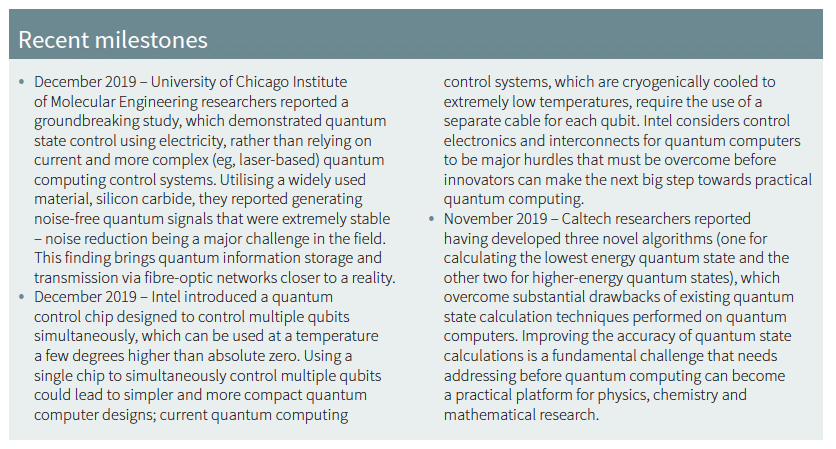
Outsized practical challenges
One major reason why patent applicants with no training or expertise in quantum computing are likely to fail to come up with an adequate written description of their invention – and thus likely to fail a Section 112 challenge – is that quantum computing-based inventions require experimentations or testing to verify what works and what does not. Indeed, determining what does not work is probably more important, if not just as important, as discovering what does.
So unless you are involved in quantum computing R&D, you will likely have no idea, when preparing and filing a quantum computing-based patent application, what works and what does not – outside of what you have read in related news articles, journal articles, press releases, patents and published patent applications.
For example, if you decide to file an application that relates to a novel quantum computing software-related invention, you will need to have a good grasp of how the various hardware components of a quantum computing system for which the software is designed work. Not knowing how a given hardware system will operate – at least in an idealised but realistic laboratory setting, in which one assumes that every hardware component works in a desired manner – makes it hard to imagine how someone can devise a software that can feasibly be used for quantum computing data collection, storage or retrieval, for quantum computing isolation system control or as part of the communications protocol for quantum computing data, signal or instruction transmission or exchange between the system and the classical computer via the quantum computing interface.
What is more, most of the critical data regarding what works and what does not is likely to be kept confidential by the scientists and engineers who discover it. The field of quantum computing is growing and because it offers the potential for what could become the foundation of life-changing technologies, competition is fierce. Thus, quantum computing research groups and companies are smart enough to withhold most, if not all, of the critical data and information that they uncover.
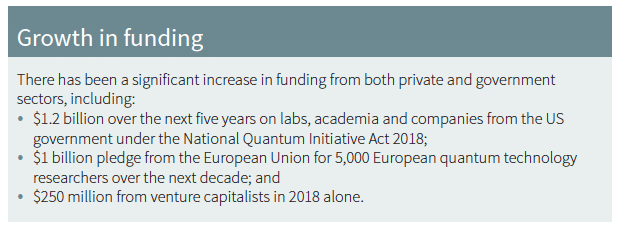
The reality is that only the biggest companies can afford to fund R&D of the many complex and complicated hardware and software components needed to create a functional quantum computing system that can perform at least one specific task at a level that would be comparable or equal to what classical computers can do.
Most scientists agree that quantum mechanics is the best theory or theoretical framework for describing microscopic systems such as atoms and molecules. But finding ways to achieve practical control of quantum mechanical systems – at a level that would permit quantum computing to become more commercially viable – is something that researchers are only just beginning to have some inkling about. We understand only bits and pieces at this point, and no one knows exactly whether quantum computing will turn out to be worth the hype and money that many governments and companies are putting into it.
